
Common name:Santa Barbara Daisy
Botanical name:Erigeron karvinskianus 'Profusion'
This herbacious perennial grows to 1' tall and 3' wide. White daisy-like flowers bloom heavily in spring and fall in the low desert but in higher elevations, bloomtime is only during the summer. The foliage is bright green and finely textured. This plant is fairly short-lived but will reseed if pruned in winter and given moderate irrigation all year. It does better in light shade if planted in the low desert.
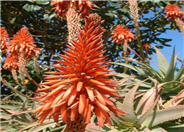
Common name:Tree Aloe
Botanical name:Aloe arborescens
This shrub is large, full of branches and produces deep orange blooms. The flowers produce a nectar that is attractive to many different birds; this plant is grown all over the world.
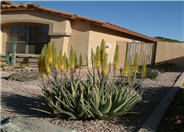
Common name:Aloe Vera or Medicinal Aloe
Botanical name:Aloe vera
The rosette of this plant consists of fleshy gray green leaves, which are narrow, succulent and erect with soft spines on margins. This Aloe is a slow to moderate grower. Flowers are spikes of yellow, 2'-3' tall and bloom late winter to summer. This aloe can form large clumps. It will tolerate full to partial sun, needs some supplemental water in heat and good drainage. It attracts hummingbirds. This aloe is a Mediterranean native. The sap is used for burns and abrasions.
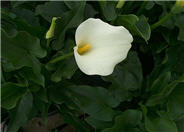
Common name:Calla Lily
Botanical name:Zantedeschia aethiopica
This perennial will grow 2'-4' tall and has large, glossy green leaves with beautiful cream or white flowers that bloom in spring and sometimes even summer.
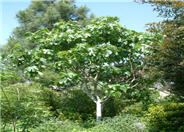
Common name:Fig Edible
Botanical name:Ficus carica
This small tree produces wonderful figs that are a brownish red color.
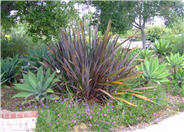
Common name:New Zealand Flax, Purple
Botanical name:Phormium tenax 'Atropurpureum'
Phormium tenax 'Atropurpureum' is an evergreen perennial. Big, dramatic plant composed of many swordlike, stiffly vertical leaves can reach 5' tall. Leaves are purple red. Flowers stems reach high above leaves, bearing clusters of 1"-2" blossoms in dark red.
| Designer: | Island Paradise |
Photographer: GardenSoft |
Soils and Compost:
Practice grass-cycling by leaving short grass clippings on lawns after mowing, so that nutrients and organic matter are returned to the soil.
Water Saving Tip:
Modify your controller each season. In the rainy season turn it off.
Integrated Pest Management:
Attract, or buy beneficial insects such as ladybugs and lacewings to control pest outbreaks in your garden.

